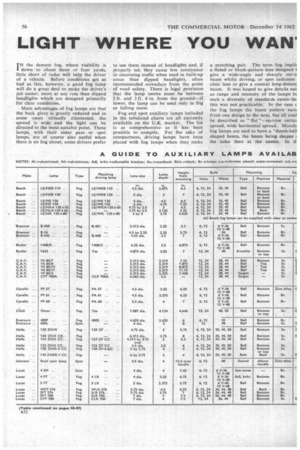LIGHT WHERE YOU WAN'
Page 58

Page 59

If you've noticed an error in this article please click here to report it so we can fix it.
By A. J. P. Wilding
I N the densest fog, where visibility is down to about three or four yards, little short of radar will help the driver of a vehicle. Before conditions get as bad as this, however, a good fog lamp will do a great deal to make the driver's job easier; more at any rate than dipped headlights which are designed primarily for clear conditions.
Main advantages of fog lamps are that the back glare is greatly reduced and in some cases virtually eliminated, the spread is wide and the light can be directed to the most suitable point. These lamps, with their sister pass or spot lamps, are of course also useful when there is no fog about; some drivers prefer to use them instead of headlights and, if properly set, they cause less annoyance to oncoming traffic when used in built-up areas than dipped headlights, often recommended nowadays from the point of road safety. There is legal provision that the lamp centre must be between 2ft. and 3 ft. 6 in, from the ground-if lower, the lamp can be used only in fog or falling snow.
Fog and spot auxiliary lamps included in the tabulated charts are all currently available on the U.K. market. The list is as comprehensive as it has been possible to compile. For. the sake of compactness, driving lamps have been placed with fog lamps when they make a matching pair. The term fog implh a fluted or block-pattern lens designed t give a wide-angle and sharply cut-o beam whilst driving, or spot indicates clear lens to give a conical long-distanc beam. It was hoped to give details sue as range and intensity of the lamps In such a diversity of standards exists•thz this was not practicable. In the case c the fog lamps the beam pattern varie from one design to the next, but all coul be described as "flat "narrow verticz spread, wide horizontal spread. Marchu .fog lamps are said to have a "dumb-hell shaped beam, the beam being deeper ; the sides than at the centre. In ti
column headed "matching driving lamp" 916 lamp designation is given where one exists. " Yes " indicates that the name or number is the same as the fog version.
In the column "lens and reflector", " separate " means where the fens and reflector are not joined together, " unit " means that the two parts are not replaceable individually and there is a conventional bulb, and "sealed beam" means the reflector and lens are permanently joined and there is no separate bulb. Top mounting position indicates that the lamp hangs down from its fixing (pendant) as against the more usual vertical mounting.




















































































































